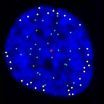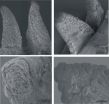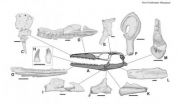(Press-News.org) LA JOLLA, CA----For humans to grow and to replace and heal damaged tissues, the body's cells must continually reproduce, a process known as "cell division," by which one cell becomes two, two become four, and so on. A key question of biomedical research is how chromosomes, which are duplicated during cell division so that each daughter cell receives an exact copy of a person's genome, are arranged during this process.
Now, scientists at the Salk Institute have discovered a new characteristic of human cell division that may help explain how our DNA is organized in the nucleus as cells reproduce. They found that telomeres, molecular caps that protect the ends of the chromosomes, move to the outer edge of the cell's nucleus after they have been duplicated.
While the implications of this spatial reorganization of telomeres are not yet clear, the findings may shed light on how our genes are regulated and how gene expression programs are altered during cell division, an important step in understanding aging and diseases that stem from genetic mutations, such as cancer.
"What we discovered is that telomeres not only protect our chromosomes, they also help organize our genetic material in the nucleus," says Jan Karlseder, a professor in Salk's Molecular and Cell Biology Laboratory and the Donald and Darlene Shiley Chair. "This is important, because the three-dimensional position of DNA in the nucleus influences gene expression profiles and how the genome morphs over time."
Telomeres, a combination of proteins and DNA, are crucial in DNA replication, tumor suppression and aging. Every time a primary human cell divides, its telomeres get shorter, until critically short telomeres lead cells to self-destruct. Much of Karlseder's research has focused on understanding telomere dynamics in order to develop ways to influence the aging process, and as a result, restrict cancer cell growth.
In addition to exploring the involvement of telomeres in premature aging diseases and interactions between the DNA damage machinery and telomeres, Karlseder studies the role of telomeres during the cell cycle. Previous studies on human cells have shown that telomeres change positions during cell division, suggesting they might also play a role in organizing DNA in the nucleus. But these studies provided only isolated snapshots of telomeres at various stages of the cell cycle.
In their new study, the Salk researchers used advanced time-lapse live-cell confocal microscopy to track telomere movement in real time throughout the cell cycle. They followed the telomeres for 20 hours in living cells by labeling them with molecules that glowed under the microscope. They also recorded the movement of chromatin, a combination of DNA and proteins that forms chromosomes.
The scientists found that the telomeres moved to the outer periphery of the nuclear envelope of each daughter cell nucleus as they assemble after mitosis, the stage of cell division during which the cell's DNA is duplicated to provide each daughter cell with its own copy. By exploring the underlying molecular pathways, the researchers determined that interactions between two proteins, RAP1 and Sun1, seem to tether the telomeres to the nuclear envelope. Sun1 alone was also capable of attracting the telomeres to the nuclear envelope, suggesting the protein is essential for the process and that other elements might be able to replace RAP1 during tethering.
"The tethering of telomeres to the nuclear envelope may serve as an anchor point to reorganize chromatin after each cell division, so that our DNA is correctly situated for gene expression," Karlseder says. "This tethering could also play a role in the maintenance of telomeres, thereby influencing aging, cancer development and other disorders associated with DNA damage. We plan to explore these possibilities in future experiments."
INFORMATION:
Other Salk Institute researchers on the paper were Laure Crabbe, Anthony J. Cesare and James M. Kasuboski and James A.J. Fitzpatrick of the Waitt Advanced Biophotonics Center Core Facility.
The research was supported by the Glenn Foundation For Medical Research, the National Institutes of Health (Grant 5T32CA009370-29), the Robert John Sabo Trust and the Highland Street Foundation.
Chromosome 'anchors' organize DNA during cell division
Salk discovery of new role for telomeres in cellular growth may shed light on aging and age-related diseases
2012-12-20
ELSE PRESS RELEASES FROM THIS DATE:
From farm to table, mealworms may be the next best food
2012-12-20
Food enthusiasts interested in sustainable farm practices may soon have a new meat alternative: insects. Beetle larvae (called mealworms) farms produce more edible protein than traditional farms for chicken, pork, beef or milk, for the same amount of land used, according to research published December 19 in the open-access journal PLOS ONE by Dennis Oonincx and colleagues from the University of Wageningen, Netherlands.
The researchers compared the environmental impact of meat production on a mealworm farm to traditional animal farms using three parameters: Land usage, ...
Human history preserved in tree rings of prehistoric wooden wells
2012-12-20
Prehistoric farming communities in Europe constructed water wells out of oak timbers, revealing that these first farmers were skilled carpenters long before metal was discovered or used for tools. The research published December 19 in the open access journal PLOS ONE by Willy Tegel and colleagues from the University of Freiburg, Germany, contradicts the common belief that metal tools were required to make complex wooden structures.
The wooden water wells discovered in eastern Germany are over 7000 years old, and suggest that these early farmers had unexpectedly refined ...
Lizard tails detach at a biological 'dotted line'
2012-12-20
Like sheets of paper marked with perforated lines, gecko tails have unique structural marks that help them sever their tails to make a quick getaway. Though voluntarily shedding a body part in this manner is a well-known phenomenon, research published December 19 in the open access journal PLOS ONE reveals aspects of the process that may have applications for structural engineers making similar, quickly detachable structures.
VIDEO:
Bridging structures are not present between ...
Music with dinner: Whales sing during foraging season, not just while breeding
2012-12-20
Humpback whales might be expected to take their food seriously given their enormous size, but a new study shows that they may multi-task as they eat, singing mating or breeding songs as they forage in their Antarctic feeding grounds. The research, published December 19 in the open-access journal PLOS ONE by Alison Stimpert from the Naval Postgraduate School and colleagues, sheds new light on the whales' singing habits in different seasons, which are still a mystery.
Whales sing most frequently during the breeding season but are known to sing on other occasions, such as ...
First freshwater mosasaur discovered
2012-12-20
A new mosasaur species discovered in Hungary is the first known example of this group of scaled reptiles to have lived in freshwater river environments similar to modern freshwater dolphins, according to research published December 19 in the open-access journal PLOS ONE by Laszlo Makadi from the Hungarian Natural History Museum, Hungary and colleagues from the University of Alberta, Canada and MTA-ELTE Lendület Dinosaur Research Group, Hungary.
The species lived about 84 million years ago, the largest specimens reached about 20 feet in length, and belongs to a family ...
Transplanted neural stem cells treat ALS in mouse model
2012-12-20
LA JOLLA, Calif., December 19, 2012 – Amyotrophic lateral sclerosis (ALS), also known as Lou Gehrig's disease, is untreatable and fatal. Nerve cells in the spinal cord die, eventually taking away a person's ability to move or even breathe. A consortium of ALS researchers at multiple institutions, including Sanford-Burnham Medical Research Institute, Brigham and Women's Hospital, and the University of Massachusetts Medical School, tested transplanted neural stem cells as a treatment for the disease. In 11 independent studies, they found that transplanting neural stem cells ...
Unraveling the threads: Simplest cotton genome offers clues for fiber improvements
2012-12-20
From the stockings decorating mantles to the new outfits in display windows calling to shoppers, cotton is woven into the fabric of the holiday season. For bioenergy researchers, however, fiber composition matters more than color and texture as each cotton strand is composed of more than two dozen coils of cellulose, a target biomass for next-generation biofuels.
In the December 20, 2012 edition of Nature, an international consortium of researchers from 31 institutions including a team from the U.S. Department of Energy Joint Genome Institute (DOE JGI) present a high-quality ...
Occasional family meals enough to boost kids' fruit and veg intake
2012-12-20
Eating meals together as a family, even if only once or twice a week, increases children's daily fruit and vegetable intake to near the recommended 5 A Day, according to researchers at the University of Leeds.
The study of primary school-aged children, funded by the National Institute for Health Research Public Health Research (NIHR PHR) Programme, also suggests parental consumption of fruit and vegetables and cutting up portions of these foods boosted children's intake. It is published today in the British Medical Journal's Journal of Epidemiology & Community Health.
Overall, ...
Stars reveal the secrets of looking young
2012-12-20
Globular clusters are spherical collections of stars, tightly bound to each other by their mutual gravity. Relics of the early years of the Universe, with ages of typically 12-13 billion years (the Big Bang took place 13.7 billion years ago), there are roughly 150 globular clusters in the Milky Way and they contain many of our galaxy's oldest stars.
But while the stars are old and the clusters formed in the distant past, astronomers using the MPG/ESO 2.2-metre telescope and the NASA/ESA Hubble Space Telescope have found that some of these clusters are still young at heart. ...
How to look young when you're not
2012-12-20
Globular clusters are spherical collections of stars, tightly bound to each other by their mutual gravity. Relics of the early years of the Universe, with ages of typically 12-13 billion years (the Big Bang took place 13.7 billion years ago), there are roughly 150 globular clusters in the Milky Way and they contain many of our galaxy's oldest stars.
But while the stars are old and the clusters formed in the distant past, astronomers using the NASA/ESA Hubble Space Telescope and the MPG/ESO 2.2-metre telescope at the ESO La Silla Observatory have found that some of these ...
LAST 30 PRESS RELEASES:
Recycling a pollutant to make ammonia production greener
Common institutional ownership linked to less aggressive business strategies in Chinese firms
Energy and regional factors drive carbon price volatility in China’s emissions trading markets
Researchers from NUS Medicine and the Institute of Mental Health detect early brain changes linked to future psychosis development
Cryopreserved vs liquid-stored platelets for the treatment of surgical bleeding
Cost-effectiveness of cryopreserved vs liquid-stored platelets for managing surgical bleeding
Adaptive Kalman filter boosts BDS-3 navigation accuracy in challenging environments
Home-based monitoring could transform care for patients receiving T-cell redirecting therapies
Listening to the 'whispers' of electrons and crystals: A quantum discovery
Report on academic exchange (colloquium) with Mapua University
Sport in middle childhood can breed respect for authority in adolescence
From novel therapies to first-in-human trials, City of Hope advances blood cancer care at the American Society of Hematology (ASH) annual conference
Research aims to strengthen the security of in-person voting machines
New study exposes hidden Alzheimer’s 'hot spots' in rural Maryland and what they reveal about America’s growing healthcare divide
ASH 2025: Study connects Agent Orange exposure to earlier and more severe cases of myelodysplastic syndrome
ASH 2025: New data highlights promise of pivekimab sunirine in two aggressive blood cancers
IADR elects George Belibasakis as vice-president
Expanding the search for quantum-ready 2D materials
White paper on leadership opportunities for AI to increase employee value released by University of Phoenix College of Doctoral Studies
ASH 2025: New combination approach aims to make CAR T more durable in lymphoma
‘Ready-made’ T-cell gene therapy tackles ‘incurable’ T-cell leukemia
How brain activity changes throughout the day
Australian scientists reveal new genetic risk for severe macular degeneration
GLP-1 receptor agonists likely have little or no effect on obesity-related cancer risk
Precision immunotherapy to improve sepsis outcomes
Insilico Medicine unveils winter edition of Pharma.AI, accelerating the path to pharmaceutical superintelligence
Study finds most people trust doctors more than AI but see its potential for cancer diagnosis
School reopening during COVID-19 pandemic associated with improvement in children’s mental health
Research alert: Old molecules show promise for fighting resistant strains of COVID-19 virus
Journal of Nuclear Medicine Technology supplement highlights advances in theranostics and opportunities for growth
[Press-News.org] Chromosome 'anchors' organize DNA during cell divisionSalk discovery of new role for telomeres in cellular growth may shed light on aging and age-related diseases







